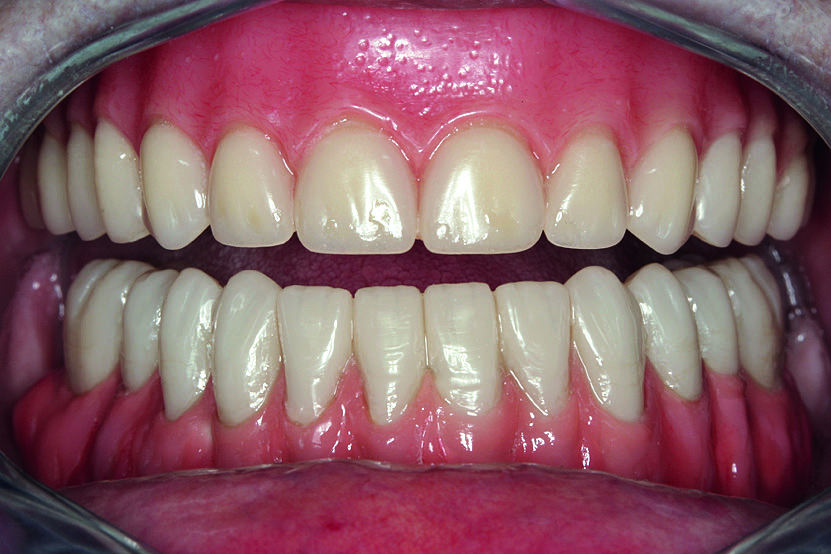Resin-Based Blocks beyond your imagination
Introduction
Implant prosthetic and dental prosthetic differ considerably, with the absence of periodontal ligament in the implant/prosthesis complex. This situation causes mechanical problems to the implants,
especially to the implant prosthetic material, due the lack of stress absorption resulting from the normal impact during chewing (1) (2). Among the problems we face in daily practice is the unscrewing and fracturing of veneering material of the implant crown and fracturing of implant/ abutment components.

normal resorption of the buccal plate.
It is very important to consider that resin-based blocks give us the missing part from ceramic materials to solve the problem of anterior exposure. It is also necessary to consider the importance of reliable bonding/union between the resin block and the abutment component of the Implant because the right transmission of occlusal load depends on the reliability of this bonding interface. One of the biggest
advantages of BRILLIANT Crios blocks is the combination with ONE COAT 7 UNIVERSAL, the best bonding system for the resin-based blocks according to the scientific literature (3) (4) and also tested in my own practice over the last five years of use.

Another very important feature is the size and distribution of ceramic fillers. We have learned from the past that bigger-size fillers are better for strength but, at the same time, are more prone to detach from the surface creating craters initiating material degradation. A homogeneous filler size and distribution is much better for the material’s wear, luster, aesthetics, and strength over the long term.
Case 1
During daily practice, it is very common to face situations where the implant has to be placed lingually due to normal resorption (Fig. 1) of the buccal plate after the extraction. But, at the same time, it is not necessary to perform bone grafting procedures. The result of this scenario is to increase the stress on the implant-bone complex when we use rigid materials like conventional ceramics. For this daily practice situation, the combination of rigid and resilient materials against the antagonist allows the stress to the implant-bone complex to be reduced. Oblique loads have been reported to increase stress values in peripheral bone and prosthetic components also generating high stress in the crown, implant, abutment, and cortical bone. Young’s modulus, also known as elastic modulus, is one of the important factors determining a material’s behavior. (5)

placement.

Case 2
Another common situation is a full-mouth restoration over the implant. It is well known that the big issue is the chipping and delimitation of the ceramics, due to the high forces applied in the patient with dental implants. In regards to this problem, the combination of rigid materials to support the connectors and resilient materials to absorb the shock and, at the same time, allow easy fixation, making the use of resin-based blocks the logical choice for this kind of restoration.


Case 3
In this case, a patient presented with extremely atrophic bone in the mandible, with four short implants placed between the dental nerve foramen (Fig, 10a,10b). After some time, patients wearing this kind of restoration with prefabricated teeth, their muscle activity increases considerably, which very often leads to fracture or debonding of the prefabricated teeth. A combination of a rigid metal structure over the telescopic bar and a thimble structure made of PEEK works as the base for the final restorations. These were milled out of a BRILLIANT Crios disc either as single tooth units or bridges and cemented on the thimble structure. Using BRILLIANT Crios instead of prefabricated teeth, we can increase the strength of the restoration, have good aesthetics, and keep the weight low for this kind of prosthesis.


secondary structure

BRILLIANT Crios restorations. Occlusal and
bottom view.
References
1. Magne P, Silva M, Oderich E, Boff LL, Enciso R. Damping behavior of implant supported restorations. Clinical Oral Implants Research. 2013;24(2):143–8.
2. Liebig J. Energy Dissipation and Damping Behavior of Commonly Used CAD / CAM Materials. 2018;35392.
3. Reymus M, Roos M, Eichberger M, Edelhoff D, Hickel R, Stawarczyk B. Bonding to new CAD/CAM resin composites: influence of air abrasion and conditioning agents as pretreatment strategy. Clinical Oral Investigations. 2019;23(2):529–38.
4. Emsermann I, Eggmann F, Krastl G, Weiger R, Amato J. Influence of Pretreatment Methods on the Adhesion of Composite and Polymer Infiltrated Ceramic CAD-CAM Blocks. The journal of adhesive dentistry. 2019;21(5):1–11.
5. Kaleli N, Sarac D, Külünk S, ztürk . Effect of the different restorative crown and customized abutment materials on stress distribution in single implants and peripheral bone: A three-dimensional finite element analysis study. Journal of Prosthetic Dentistry [Internet]. 2017;1–9. Available from: http:// dx.doi.org/10.1016/j.prosdent.2017.03.008

CONTACT
DOA Dental Clinic
Dr. Nicolas Gutierrez Robledo
Calle Alcala 199 28028 Madrid Spain


